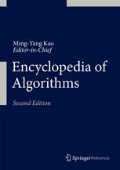Access this chapter
Tax calculation will be finalised at checkout
Purchases are for personal use only
Recommended Reading
Andersson G, Engebretsen L, Håstad J (2001) A new way to use semidefinite programming with applications to linear equations mod p. J Algorithms 39:162–204
Arora S, Rao S, Vazirani U (2004) Expander flows, geometric embeddings and graph partitioning. In: Proceedings of the 36th annual symposium on the theory of computing (STOC), Chicago, pp 222–231
Barahona F (1993) On cuts and matchings in planar graphs. Math Program 60:53–68
Blum A, Konjevod G, Ravi R, Vempala S (2000) Semi-definite relaxations for minimum bandwidth and other vertex-ordering problems. Theor Comput Sci 235:25–42
Charikar M, Guruswami V, Wirth A (2003) Clustering with qualitative information. In: Proceedings of the 44th annual IEEE symposium on foundations of computer science (FOCS), Boston, pp 524–533
Chor B, Sudan M (1998) A geometric approach to betweeness. SIAM J Discret Math 11:511–523
de Klerk E, Pasechnik DV, Warners JP (2004) On approximate graph colouring and MAX-k-CUT algorithms based on the \(\theta\) function. J Comb Optim 8(3):267–294
Delorme C, Poljak S (1993) Laplacian eigenvalues and the maximum cut problem. Math Program 62:557–574
Delorme C, Poljak S (1993) The performance of an eigenvalue bound in some classes of graphs. Discret Math 111:145–156. Also appeared in Proceedings of the conference on combinatorics, Marseille, 1990
Feige U, Schechtman G (2002) On the optimality of the random hyperplane rounding technique for MAX-CUT. Random Struct Algorithms 20(3):403–440
Frieze A, Jerrum MR (1997) Improved approximation algorithms for MAX-k-CUT and MAX BISECTION. Algorithmica 18:61–77
Goemans MX, Williamson DP (1995) Improved approximation algorithms for maximum cut and satisfiability problems using semidefinite programming. J ACM 42:1115–1145
Goemans MX, Williamson DP (2004) Approximation algorithms for MAX-3-CUT and other problems via complex semidefinite programming. STOC 2001 Spec Issue J Comput Syst Sci 68:442–470
Grötschel M, Lovász L, Schrijver A (1981) The ellipsoid method and its consequences in combinatorial optimization. Combinatorica 1:169–197
Grötschel M, Lovász L, Schrijver A (1988) Geometric algorithms and combinatorial optimization. Springer, Berlin
Halperin E, Zwick U (2002) A unified framework for obtaining improved approximation algorithms for maximum graph bisection problems. Random Struct Algorithms 20(3):382–402
Håstad J (2001) Some optimal inapproximability results. J ACM 48:798–869
Karger DR, Motwani R, Sudan M (1998) Improved graph coloring via semidefinite programming. J ACM 45(2):246–265
Karloff HJ (1999) How good is the Goemans-Williamson MAX CUT algorithm? SIAM J Comput 29(1):336–350
Karp RM (1972) Reducibility among combinatorial problems. In: Complexity of computer computations. Plenum, New York, pp 85–104
Khot S (2002) On the power of unique 2-prover 1-round games. In: Proceedings of the 34th annual symposium on the theory of computing (STOC), Montreal, pp 767–775
Khot S, Kindler G, Mossel E, O’Donnell R (2004) Optimal inapproximability results for MAX CUT and other 2-variable CSPs? In: Proceedings of the 45th annual IEEE symposium on foundations of computer science (FOCS), Rome, pp 146–154
Mahajan R, Hariharan R (1995) Derandomizing semidefinite programming based approximation algorithms. In: Proceedings of the 36th annual IEEE symposium on foundations of computer science (FOCS), Milwaukee, pp 162–169
Mohar B, Poljak S (1990) Eigenvalues and the max-cut problem. Czech Math J 40(115):343–352
Newman A (2004) A note on polyhedral relaxations for the maximum cut problem. Unpublished manuscript
Poljak S (1992) Polyhedral and eigenvalue approximations of the max-cut problem. Sets Graphs Numbers Colloqiua Mathematica Societatis Janos Bolyai 60:569–581
Poljak S, Rendl F (1994) Node and edge relaxations of the max-cut problem. Computing 52:123–137
Poljak S, Rendl F (1995) Nonpolyhedral relaxations of graph-bisection problems. SIAM J Optim 5:467–487
Poljak S, Rendl F (1995) Solving the max-cut using eigenvalues. Discret Appl Math 62(1–3):249–278
Poljak S, Tuza Z (1995) Maximum cuts and large bipartite subgraphs. DIMACS Ser Discret Math Theor Comput Sci 20:181–244
Sahni S, Gonzalez T (1976) P-complete approximation problems. J ACM 23(3):555–565
Soto JA (2015) Improved analysis of a max-cut algorithm based on spectral partitioning. SIAM J Discret Math 29(1):259–268
Swamy C (2004) Correlation clustering: maximizing agreements via semidefinite programming. In: Proceedings of 15th annual ACM-SIAM symposium on discrete algorithms (SODA), New Orleans, pp 526–527
Trevisan L (2012) Max cut and the smallest eigenvalue. SIAM J Comput 41(6):1769–1786
Trevisan L, Sorkin GB, Sudan M, Williamson DP (2000) Gadgets, approximation, and linear programming. SIAM J Comput 29(6): 2074–2097
Author information
Authors and Affiliations
Corresponding author
Editor information
Editors and Affiliations
Rights and permissions
Copyright information
© 2016 Springer Science+Business Media New York
About this entry
Cite this entry
Newman, A. (2016). Max Cut. In: Kao, MY. (eds) Encyclopedia of Algorithms. Springer, New York, NY. https://doi.org/10.1007/978-1-4939-2864-4_219
Download citation
DOI: https://doi.org/10.1007/978-1-4939-2864-4_219
Published:
Publisher Name: Springer, New York, NY
Print ISBN: 978-1-4939-2863-7
Online ISBN: 978-1-4939-2864-4
eBook Packages: Computer ScienceReference Module Computer Science and Engineering

